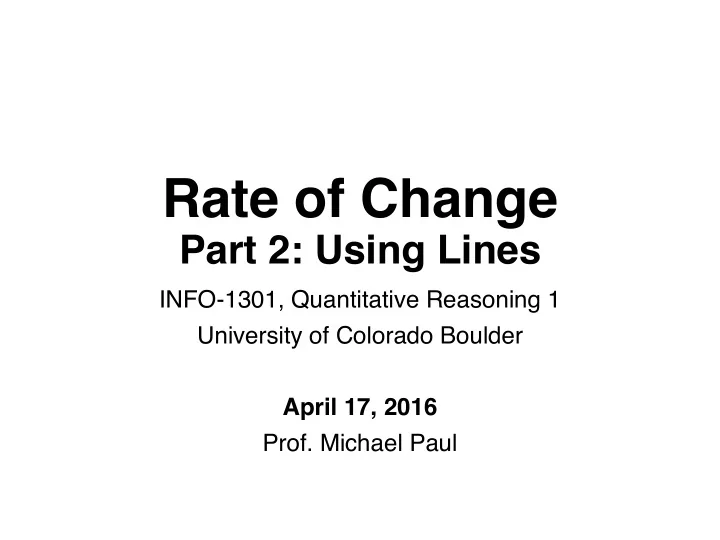

Rate of Change Part 2: Using Lines INFO-1301, Quantitative Reasoning 1 University of Colorado Boulder April 17, 2016 Prof. Michael Paul
Interpreting Linear Functions Fishermen in the Finger Lakes Region have been recording the dead fish they encounter while fishing in the region. The Department of Environmental Conservation monitors the pollution index for the Finger Lakes Region. The model for the number of fish deaths y for a given pollution index x is y = 9.607x + 111.958. What is the meaning of the slope? What is the meaning of the y-intercept?
Interpreting Linear Functions Fishermen in the Finger Lakes Region have been recording the dead fish they encounter while fishing in the region. The Department of Environmental Conservation monitors the pollution index for the Finger Lakes Region. The model for the number of fish deaths y for a given pollution index x is y = 9.607x + 111.958. What can we do with this function? • Estimate fish deaths for pollution values that we’ve never measured
Interpolation and Extrapolation y = 9.607x + 111.958 x is the pollution index Suppose we came up with this formula as an approximation after measuring fish deaths when the pollution index was: 1.1, 1.8, 2.5, 3.0, 3.9, 5.2 • What if we wanted to know deaths at x=3.5? Interpolation is when we use our linear function to estimate a value at a point in between points we have already measured
Interpolation and Extrapolation y = 9.607x + 111.958 x is the pollution index Suppose we came up with this formula as an approximation after measuring fish deaths when the pollution index was: 1.1, 1.8, 2.5, 3.0, 3.9, 5.2 • What if we wanted to know deaths at x=7.0? Extrapolation is when we use our linear function to estimate a value at a point outside of points we have already measured • Why might this fail?
Interpolation and Extrapolation In general, interpolation will be more accurate than extrapolation Sometimes you can intuitively reason about when and why extrapolation will or will not work • You have some knowledge of chemistry and biology that there is an upper limit to how much pollution fish can take before they all die
Interpolation and Extrapolation In general, interpolation will be more accurate than extrapolation Sometimes you can see what is reasonable by examining your data • Visually see regions where the line is a good or bad fit
Interpolation and Extrapolation The average lifespan of Americans has increased over time. The average lifespan of an American in a given year is approximately y = 0.2x + 73, where x is the number of years since 1960. What was the approximate lifespan in 1980? What will be the approximate lifespan in 2020? What will be the approximate lifespan in 2400? • Unknown in 2400. This model is likely a bad approximation for that large of an interval.
Differencing A special type of slope is the difference in y-value between consecutive points • Assuming consistent interval of width 1 along x For two adjacent points: y i – y i –1 e.g., y 2 – y 1 y 5 – y 4 The sign of the difference tells you whether it increased or decreased from the previous point
Original: Difference: When the difference changes from positive to negative, it means we passed a peak
Differencing Positive difference means increasing Negative difference means decreasing Change from positive to negative means there is a peak Change from negative to positive means there is a trough
Maxima and Minima Whenever there is a peak in the data, this is a maximum The global maximum is the highest peak in the entire data set (the largest y-value) A local maximum is any peak, when the rate of change between to consecutive points (or difference) switches from positive to negative
Maxima and Minima Whenever there is a trough in the data, this is a minimum The global minimum is the lowest trough in the entire data set (the smallest y-value) A local minimum is any trough, when the rate of change between to consecutive points (or difference) switches from negative to positive
Maxima and Minima All global maxima and minima are also local maxima and minima • The reverse is not true.
Practice Identify all global and local maxima and minima
Recommend
More recommend